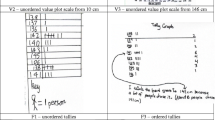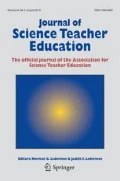Abstract
Measurement is an essential skill that students need to develop in both mathematics and science classes. However, many students only develop very superficial understanding regarding the nature of measurement. Building upon modeling-based work, we construct a framework that views measurement as a complex set of knowledge and skills one can use to transform a model and/or a referent and their variations and bring them together in a coherent way. We use this framework to guide the design and implementation of a unit on measuring the volume of a tree with two cohorts of prospective teachers of middle grades. With selected examples, we illustrate our framework in terms of the relationship between modeling and measurement. We provide insights on how to design activities that enhance students’ in-depth understanding of measurement.






Similar content being viewed by others

References
American Association for the Advancement of Science. (2009). Benchmarks online. Retrieved March 12, 2012, from the Project 2061 website: http://www.project2061.org/publications/bsl/online/index.php?home=true.
Battista, M. T. (2007). The development of geometric and spatial thinking. In F. Lester (Ed.), NCTM second handbook of research on mathematics teaching and learning (Vol. 2, pp. 843–908). Reston, VA: National Council of Teachers of Mathematics.
Capon, N., & Kuhn, D. (2004). What’s so good about problem-based learning? Cognition and Instruction, 22, 61–79.
Enriquez, R. (2011). Role-playing in a modeling-based unit on electricity for preservice middle school science teachers. Unpublished master’s thesis. University of Georgia, Athens, GA.
Gabel, D. R. (1993). Introductory science skills (2nd ed.). Prospect Heights, IL: Waveland Press.
Gilbert, J. K. (1993). Models & modeling in science education. Hatfield: The Association for Science Education.
Hestenes, D. (1987). Toward a modeling theory of physics instruction. American Journal of Physics, 55, 440–454.
Hestenes, D., Wells, M., & Swackhamer, G. (1992). Force concept inventory. The Physics Teacher, 30, 141–158.
Hewitt, P. G. (2008). Conceptual physics (10th ed.). Boston, MA: Addison Wesley.
Hmelo-Silver, C. E. (2004). Problem-based learning: What and how do students learn? Educational Psychology Review, 16, 235–266.
Lehrer, R., & Schauble, L. (2000). Developing model-based reasoning in mathematics and science. Journal of Applied Developmental Psychology, 21(1), 39–48.
Lehrer, R., & Schauble, L. (2004). Modeling natural variation through distribution. American Educational Research Journal, 41, 635–679.
Lewin, W. (1999). Units, dimensions, and scaling arguments. Retrieved March 12, 2012, from MIT open course website: http://ocw.mit.edu/courses/physics/8-01-physics-i-classical-mechanics-fall-1999/video-lectures/lecture-1/.
Linn, M. C., & Songer, N. (1991). Teaching thermodynamics to middle school students: What are appropriate cognitive demands? Journal of Research in Science Teaching, 28, 885–918.
Minner, D. D., Levy, A. J., & Century, J. (2010). Inquiry-based science instruction—what is it and does it matter? Results from a research synthesis years 1984 to 2002. Journal of Research in Science Teaching, 47, 474–496.
National Research Council. (2000). Inquiry and the National Science Education Standards. Washington, DC: The National Academies Press.
National Research Council. (2004). On evaluating curricular effectiveness: Judging the quality of K-12 mathematics evaluations. Washington, DC: TheNational Academies Press.
National Research Council. (2012). A Framework for K-12 science education: Practices, crosscutting concepts, and core ideas. Washington, DC: The National Academies Press.
Passmore, C., & Stewart, J. (2002). A modeling approach to teaching evolutionary biology in high school. Journal of Research in Science Teaching, 39, 185–204.
Rezba, R. J., Sprague, C., Fiel, R. L., & Funk, H. J. (1995). Learning and assessing science process skills. Dubuque, IA: Kendall-Hunt.
Savery, J. (2006). Overview of problem-based learning: Definitions and distinctions. The Interdisciplinary Journal of Problem-based Learning, 1(1), 9–20.
Schwarz, C. V., Reiser, B. J., Davis, E. A., Kenyon, L., Acher, A., Fortus, D., et al. (2009). Developing a learning progression for scientific modeling: Making scientific modeling accessible and meaningful for learners. Journal of Research in Science Teaching, 46, 632–654.
Shen, J. (2011). A transformative modeling perspective on the use of manipulative materials for conceptual learning in science education. Available from https://sites.google.com/site/shenresearch/publications.
Shen, J., & Confrey, J. (2007). From conceptual change to transformative modeling: A case study of an elementary teacher in learning astronomy. Science Education, 91(6), 948–966.
Shen, J., & Confrey, J. (2010). Justifying alternative models in learning the solar system: A case study on K-8 science teachers’ understanding of frames of reference. International Journal of Science Education, 32(1), 1–29.
Shen, J., Gibbons, P. C., Wiegers, J. F., & McMahon, A. (2007). Using research based assessment tools in professional development in current electricity. Journal of Science Teacher Education, 18(3), 431–459.
Shen, J., Jing, L., Chang, H., & Namdar, B. (in press). Technology-enhanced, modeling-based instruction (TMBI) in science education. In J. M. Spector, M. D., Merrill, J. Elen, & M. J., Bishop (Eds.), Handbook of research on educational communication and technology (4th ed., Chap. 46). New York: Springer.
Strauss, A., & Corbin, J. (1998). Basics of qualitative research: Techniques and procedures for developing grounded theory. Thousand Oaks, CA: Sage.
Strobel, J., & van Barneveld, A. (2009). When is PBL more effective? A meta-synthesis of meta-analyses comparing PBL to conventional classrooms. Interdisciplinary Journal of Problem-based Learning, 3(1), 44–58.
Tretter, T. R., Jones, M. G., Andre, T., Negishi, A., & Minogue, J. (2006a). Conceptual boundaries and distances: Students’ and adults’ concepts of the scale of scientific Phenomena. Journal of Research in Science Teaching, 43, 282–319.
Tretter, T. R., Jones, M. G., & Minogue, J. (2006b). Accuracy of scale conceptions in science: Mental maneuverings across many orders of spatial magnitude. Journal of Research in Science Teaching, 43, 1061–1085.
White, B. (1993). ThinkerTools: Causal models, conceptual change, and science education. Cognition and Instruction, 10, 1–100.
Windschitl, M., Thompson, J., & Braaten, M. (2008). Beyond the scientific method: Model-based inquiry as a new paradigm of preference for school science investigations. Science Education, 92, 941–967.
Wu, H.-K., Krajcik, J. S., & Soloway, E. (2001). Promoting understanding of chemical representations: Students’ use of a visualization tool in the classroom. Journal of Research in Science Teaching, 38, 821–842.
Zhang, B., Liu, X., & Krajcik, J. S. (2001). Expert models and modeling processes associated with computer-modeling tool. Science Education, 90, 579–604.
Author information
Authors and Affiliations
Corresponding author
About this article
Cite this article
Shen, J., Jackson, D.F. Measure the Volume of a Tree: A Transformative Modeling Lesson on Measurement for Prospective Middle-school Science Teachers. J Sci Teacher Educ 24, 225–247 (2013). https://doi.org/10.1007/s10972-012-9308-x
Published:
Issue Date:
DOI: https://doi.org/10.1007/s10972-012-9308-x



